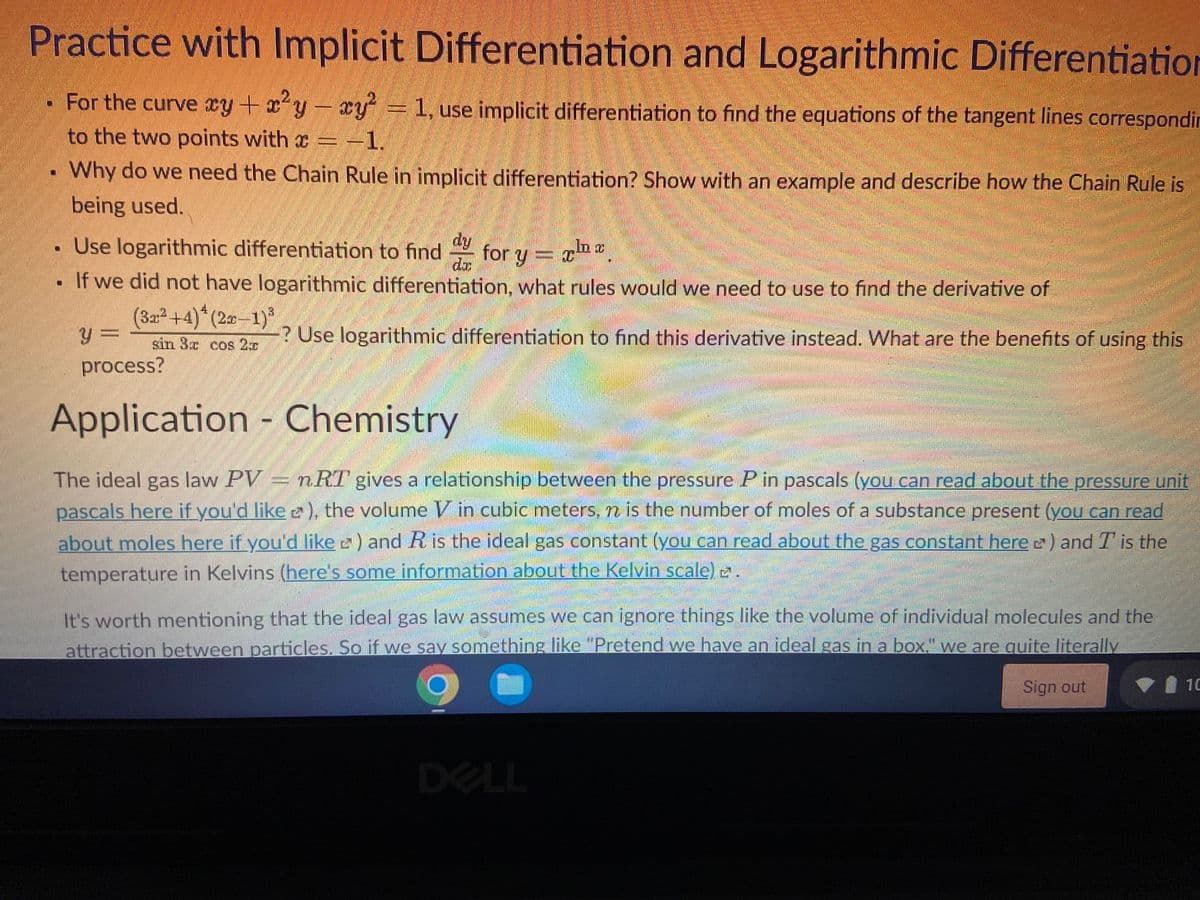. If we did not have logarithmic differentiation, what rules would we need to use to find the derivative of (32²+4)*(2x-1)³ Y = sin 3x cos 2x process? -? Use logarithmic differentiation to find this derivative instead. What are the benefits of using this
. If we did not have logarithmic differentiation, what rules would we need to use to find the derivative of (32²+4)*(2x-1)³ Y = sin 3x cos 2x process? -? Use logarithmic differentiation to find this derivative instead. What are the benefits of using this
Advanced Engineering Mathematics
10th Edition
ISBN:9780470458365
Author:Erwin Kreyszig
Publisher:Erwin Kreyszig
Chapter2: Second-order Linear Odes
Section: Chapter Questions
Problem 1RQ
Related questions
Question
100%
I am seeking help on the bullet point that asks: If we did not have logarithmic differentiation....

Transcribed Image Text:Practice with Implicit Differentiation and Logarithmic Differentiation
. For the curve xy + x²y - xy² = 1, use implicit differentiation to find the equations of the tangent lines correspondin
to the two points with = -1.
Why do we need the Chain Rule in implicit differentiation? Show with an example and describe how the Chain Rule is
being used.
Use logarithmic differentiation to find for y =
dy
xlx
da
If we did not have logarithmic differentiation, what rules would we need to use to find the derivative of
(322+4)* (2x-1)³
? Use logarithmic differentiation to find this derivative instead. What are the benefits of using this
Y=
sin 3 cos 20
process?
AGERARE
Percontener
Application - Chemistry
The ideal gas law PV nRT gives a relationship between the pressure P in pascals (you can read about the pressure unit
pascals here if you'd like), the volume V in cubic meters, n is the number of moles of a substance present (you can read
about moles here if you'd like e) and R is the ideal gas constant (you can read about the gas constant here) and T' is the
temperature in Kelvins (here's some information about the Kelvin scale).
It's worth mentioning that the ideal gas law assumes we can ignore things like the volume of individual molecules and the
attraction between particles. So if we say something like "Pretend we have an ideal gas in a box," we are quite literally
Sign out
10
DELL
Expert Solution
This question has been solved!
Explore an expertly crafted, step-by-step solution for a thorough understanding of key concepts.
Step by step
Solved in 5 steps with 2 images

Recommended textbooks for you

Advanced Engineering Mathematics
Advanced Math
ISBN:
9780470458365
Author:
Erwin Kreyszig
Publisher:
Wiley, John & Sons, Incorporated

Numerical Methods for Engineers
Advanced Math
ISBN:
9780073397924
Author:
Steven C. Chapra Dr., Raymond P. Canale
Publisher:
McGraw-Hill Education

Introductory Mathematics for Engineering Applicat…
Advanced Math
ISBN:
9781118141809
Author:
Nathan Klingbeil
Publisher:
WILEY

Advanced Engineering Mathematics
Advanced Math
ISBN:
9780470458365
Author:
Erwin Kreyszig
Publisher:
Wiley, John & Sons, Incorporated

Numerical Methods for Engineers
Advanced Math
ISBN:
9780073397924
Author:
Steven C. Chapra Dr., Raymond P. Canale
Publisher:
McGraw-Hill Education

Introductory Mathematics for Engineering Applicat…
Advanced Math
ISBN:
9781118141809
Author:
Nathan Klingbeil
Publisher:
WILEY

Mathematics For Machine Technology
Advanced Math
ISBN:
9781337798310
Author:
Peterson, John.
Publisher:
Cengage Learning,

